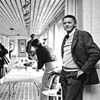 Vilhelm Wohlert
Vilhelm Wohlert
Vilhelm Wohlert (1920-2007), Denmark. Born in 1920, Wohlert was a modest man who never sought the limelight. He was also an intrepid traveller who worked as far afield as India, Tunisia, and Afghanistan. Wohlert began his career in Klint's office before going on to teach at Berkeley in California. Here he came into contact with the 'Bay Area' architects, who had taken the English Arts and Crafts ideals and fused them with a passion for traditional Japanese architecture, ideas that he took to Denmark. Denmark was a major force in architecture and design in the 1950's and 1960's and the work of Vilhelm Wohlert epitomises 'Danish design' from that period. Vilhelm Wohlert designed the world famous Louisiana Museum of Art with his friend Jorgen Bo in 1958. The Louisiana Museum of Art became one of the key buildings of the 20th century. While the Louisiana Museum found fame, Wohlert remained largely unknown. Yet he became visible among the architectural fraternity in 1957 with an exquisite optician's shop in central Copenhagen, in which he designed not just the interior but also all the furniture and light fittings. That same year he built a modest guest pavilion for the physicist Niels Bohr which was a kind of timber Farnsworth house - a deceptively simple floating box that opened up in stages to follow the seasons by means of doors and shutters. These buildings reveal Wohlert's attention to detail and jointing, a skill acquired at the Academy of Fine Arts under the guidance of Kaare Klint, who had established a School of Furniture there so that architects and cabinet makers worked side by side. With Bo, he built two more museums in Hamm and Bochum, Germany. In Denmark he built several churches and a number of houses that provide an exemplar of the Danish vision of modern domestic architecture. |
